Reasons to consider on-site Nitrogen Generation
15/10/2019 12:17 pm
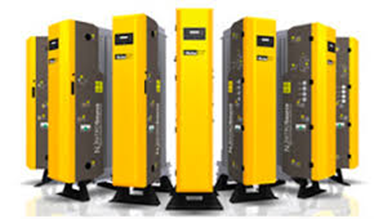
Most of the world’s industrial nitrogen is created through large scale cryogenic separation at an Air Separation Unit (ASU). This is normally sold to end users as a liquid at nearly -200°C and stored in insulated vessels or it is evaporated to a gas and compressed at pressures up to 300 barg into high-pressure cylinders.
However, there is a better and more sustainable option, which is to become self-sufficient and produce your own nitrogen gas with an on-site nitrogen generator. This not only eliminates the on-going costs associated with bulk delivery and storage, but also offers significant safety advantages.
This blog examines the three traditional gas supply methods and reasons why plant managers should consider using an on-site nitrogen generator as an alternative.
Cylinders and manifold cylinder packs (MCP)
Single nitrogen cylinders and manifold cylinder packs are supplied in a variety of volumes and fill pressures. A major pitfall in using cylinders is that the stated cylinder capacity is not the actual usable gas volume, this depends on required delivery pressure and the need to guarantee the purity of gas.
The main reason for industry dependence on gas cylinders is that this is the way it has always been done, and plant personnel are comfortable with the process. Plant managers may be unaware that there are hidden costs with cylinders that can add up fast and significantly increase overall operating expenses.
Rental costs
Usually, three cylinders or MCPs are on site at any one time. One empty awaiting collection, one in use, and one full awaiting connection. All will be charged rental fees.
Location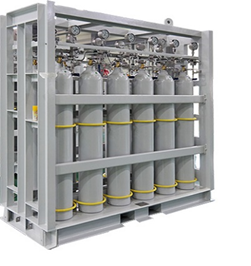
Cylinders have to be secured in purpose-built racks for safety. MCPs have a large footprint and take up valuable floor space. Both need to be located in an area where a sudden release of gas cannot cause asphyxiation.
Handling
Cylinders and MCPs are heavy and require special equipment to manoeuvre them into position — a time consuming and costly process, not to mention the safety implications.
Wastage due to pressure loss
To ensure gas quality above 34 barg cylinder pressure, most industrial applications require a laboratory grade, built-in purifier cylinder equipped with internal consumable adsorbents, which adds considerable cost.
A standard 230 bar g cylinder carries the risk that the remaining 14% percent of the gas in the cylinder could be contaminated with water vapour and organic impurities (such as oils). These impurities are adsorbed into the surface of the cylinder walls and desorbed as the pressure reaches and drops below 34 barg.
This contamination can build up over time and coat the pipework, regulators and application. The only way to prevent it is to stop using the cylinder supply when the pressure drops to 34 barg. This equates to a 14 percent waste of money and gas for every cylinder or MCP.
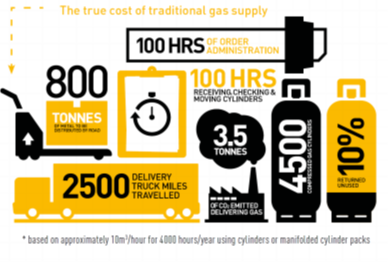
Mini-bulk storage
Insulated liquid nitrogen vessels include an integral evaporator to convert the stored liquid to a usable gas. Mini tanks are supplied in various capacities and pressure options, and share all of the above highlighted issues with gas cylinders but also have one particularly unique concern: off-gassing. Off-gassing is a problem common to all types of gaseous liquid storage as liquid nitrogen is constantly being converted to gas and so leaks out from the dewars. Therefore, if a company is not constantly using its supply, it is slowly being wasted.
Low flow rates.
Because of the internal evaporator, flow rates are limited to relatively low levels given the stored capacity.
Temperature duty cycle
Also, due to the internal evaporator, extra time must be allowed for the temperature to achieve a sufficient level so as to ensure complete evaporation of the liquid.
Static evaporation losses
It is not possible to have a 100% efficient heat insulated vessel, so ambient conditions cause the liquid to heat up and evaporate. It is then vented to atmosphere (wasted), through a safety valve to prevent over pressurization on the vessel.
Some vessels have an economiser circuit that allows gas boil-off in the liquid vessel to be transferred to the gaseous phase of the evaporator. However, this is only useful when gas is being used by the application. When the economiser is not in use, the pressure builds and it is lost to atmosphere.
Bulk liquid vessels
Whilst companies don’t have to worry as much about operator liability or workplace safety, bulk storage tanks have their own set of hidden costs to be aware of.
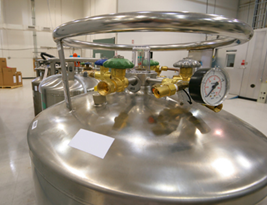
Bulk vessel heat leak
Cryogenic liquid storage vessels are designed to be as efficient as possible to minimize heating of the very cold liquid nitrogen at -196°C. However, some heat leak into the vessel is inevitable as no vacuum vessel is 100% efficient. The heat absorbed by the liquid will cause some of it to be vaporized into gas. This gas is called boil off. This boil-off is:
- Retained within the tank causing the pressure of the gas to rise
- Used by the customer through the economiser circuit
- If it is retained within the tank and the pressure rises above the safety limit, it will be vented to atmosphere and wasted
In reality, a certain amount of all three scenarios will occur. However, the more intermittent the demand for gas, the more potential there is for waste through boil off.
The table below details a typical monthly boil-off rates.

Demand
A liquid tank used for standby, back-up or peak shaving is potentially very wasteful due to lack of demand or high boil-off rate. If a customer has too big a vessel for their application (for example if they originally had a high demand then this dropped but they kept the original vessel), there is a high potential for gas wastage.
If not used, a bulk vessel will lose all of its contents within approximately 3 months.
On-site nitrogen gas generation
Nitrogen generators utilize proprietary selective permeation membrane and pressure swing absorption (PSA) technologies to produce high purity nitrogen from compressed air. Nitrogen generators are designed to continually transform standard compressed air into nitrogen as safe, regulated pressures without operator attention. An on-site N2 generator will eliminate all of the above problems and increase profitability, reliability and sustainability.
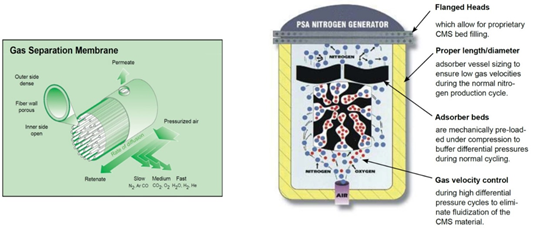
A Parker NITROSource generator, for example, offers a unique design and advanced energy-saving technology that requires less compressed air to generate more nitrogen. Substantially lower servicing costs, reduced downtime, and longer working life make it the most cost-efficient nitrogen supply available. Additional benefits include:
- Increased profitability – significantly lower unit gas cost, more up-time, NITROSource also incorporates energy-saving technology which matches demand to the application resulting in the user making further savings
- Increased reliability – gas available on demand 24/7, only pay for gas produced
- Sustainability – short payback on investment, long service life, low energy use and reduced CO2 footprint
With Parker’s vast industrial application knowledge gleaned over almost 30 years of designing and manufacturing gas generation systems, VFV is ideally suited to be able to help any customer to convert from delivered gas options to produce their own gas on demand.
For information on how Parker's NITROSource System can help with your gas needs please contact VFV at [email protected].
Jonathan Barlow
You must be logged in to post a comment.
click here to log in
